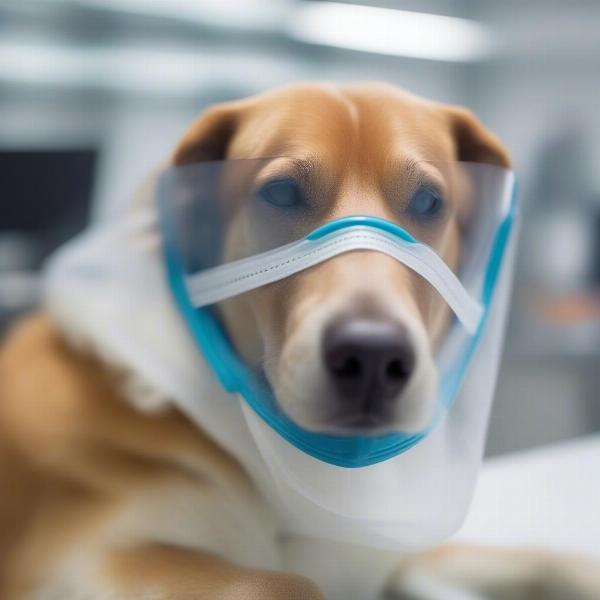Dog masks serve a variety of purposes, from practical applications to playful costumes. Understanding their function is key to choosing the right mask for your canine companion. This article will delve into the different types of dog masks available, their benefits, and potential drawbacks, as well as tips for proper usage.
Why Use a Dog Mask?
Dog masks can be utilized for a range of reasons, including protection, behavior modification, and even fashion. Some common applications include:
- Protection from environmental hazards: Masks can shield a dog’s face from dust, debris, and extreme weather conditions.
- Muzzle alternative: In certain situations, a mask can serve as a less restrictive alternative to a traditional muzzle.
- Anxiety reduction: Some masks are designed to help calm anxious dogs during stressful situations like thunderstorms or fireworks.
- Post-surgery recovery: Masks can prevent dogs from licking or biting at wounds after surgery.
- Costume and playful purposes: Many masks are designed for purely aesthetic reasons, adding a touch of fun to your dog’s appearance.
Types of Dog Masks
The market offers a variety of dog masks, each designed for a specific purpose. Some of the most common types include:
- Muzzle Masks: These masks offer more complete facial coverage than traditional muzzles, often used for aggressive dogs or in situations requiring extra restraint.
- Mesh Masks: Breathable and lightweight, mesh masks are ideal for hot weather or active dogs, offering protection without hindering their breathing.
- Cloth Masks: These masks are typically used for fashion or costume purposes.
- Recovery Masks: Specifically designed for post-surgery recovery, these masks prevent dogs from interfering with wounds.
- bull dog mask
Choosing the Right Mask for Your Dog
Selecting the appropriate mask depends on several factors:
- Purpose: Consider why you need a mask for your dog. Is it for protection, behavior modification, or aesthetic purposes?
- Size and Fit: Ensure the mask fits snugly but comfortably, allowing your dog to pant and breathe easily.
- Material: Choose a material that is durable, breathable, and easy to clean.
- Dog’s Temperament: A dog’s personality plays a crucial role in determining their acceptance of a mask.
 Dog wearing a protective mask
Dog wearing a protective mask
Introducing Your Dog to a Mask
Introducing a mask gradually is crucial to ensure your dog’s comfort. Start by allowing your dog to sniff and investigate the mask. Then, try briefly placing the mask on their face, rewarding them with positive reinforcement. Gradually increase the duration of wear, associating the mask with positive experiences.
Potential Drawbacks and Considerations
While dog masks can be beneficial, it’s essential to be aware of potential drawbacks:
- Discomfort: An improperly fitted mask can cause discomfort or restrict breathing.
- Overheating: Masks can increase the risk of overheating, especially in hot weather.
- Stress and Anxiety: Some dogs may find wearing a mask stressful or anxiety-inducing.
- dog mask german shepherd
Monitoring Your Dog While Wearing a Mask
Always supervise your dog while wearing a mask. Monitor their breathing and ensure they are not exhibiting signs of distress or discomfort. Never leave a dog wearing a mask unattended.
Conclusion
Dog masks can be valuable tools for a variety of purposes, from protecting your dog’s face to managing their behavior. Choosing the right mask and introducing it properly are key to ensuring a positive experience for your canine companion. Remember to prioritize your dog’s comfort and safety, and always supervise them while wearing a mask.
FAQ
- Are dog masks cruel? Not necessarily. Properly fitted masks used for legitimate purposes, like protection or recovery, are not inherently cruel. However, improperly fitted or misused masks can cause discomfort and stress.
- Can my dog eat or drink while wearing a mask? This depends on the type of mask. Some masks allow for eating and drinking, while others do not.
- How do I clean a dog mask? Follow the manufacturer’s instructions for cleaning. Most masks can be washed with soap and water.
- Are there any breeds that shouldn’t wear masks? Brachycephalic breeds (those with short noses) may have difficulty breathing in certain types of masks. Consult your veterinarian for guidance.
- Can I use a dog mask to stop my dog from barking? While some masks may muffle barking, they are not a long-term solution for excessive barking. Consult a professional dog trainer for behavioral modification techniques.
- dog mask for dogs
- dog foxtail mask
Related Articles
About ILM Dog
ILM Dog (ilmdog.com) is a leading online resource for dog owners worldwide, offering expert advice on all aspects of canine care, from breed selection and health to training, nutrition, and grooming. We are committed to providing practical, reliable information to help you give your furry friend the best possible life. Our experts cover key areas like choosing the right breed, maintaining optimal health, implementing effective training, ensuring proper nutrition, and maintaining proper hygiene. For any questions or to connect with our team, please contact us at [email protected] or call us at +44 20-3965-8624.